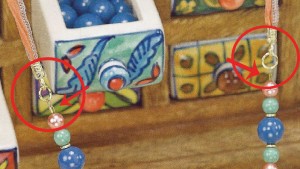 I named this little company “Professional Pearl and Bead Stringing” for a reason. I wanted to distinguish it from other types of pearl and bead stringing, specifically the all-too-widespread practice of teaching one technique, such as using crimps, and then stopping.
I named this little company “Professional Pearl and Bead Stringing” for a reason. I wanted to distinguish it from other types of pearl and bead stringing, specifically the all-too-widespread practice of teaching one technique, such as using crimps, and then stopping.
Now, of course, there’s nothing “wrong” with crimping jewelry, unless you are a professional pearl and bead stringer. If you sell jewelry, and if you’re dedicated to learning about jewelry and technique, you will sell your jewelry because people will want to buy it, sometimes literally right off your neck.
This means you must learn to look at jewelry critically. Not for personal criticism but to observe where the manufacturer did well and conversely where the manufacturer fell short.
Yesterday I received one of the jewelry making publications that have grown in such popularity in recent years.
The picture above was scanned from the inside front cover. It is part of an ad run by a jewelry supply company.
Frankly, I was appalled. Not at the design. The concept of uniting two different materials in the same necklace is a good one. (In fact, it’s one I teach in the Advanced Professional Pearl and Bead Stringing DVD.)
What bothers me is the prominence of the findings in the center of the necklace. Those findings, the jump ring and the crimp, distract the eye from the design. They’re unsightly. And they tell any critical observer that the necklace was manufactured by an amateur.
The entire problem could be eliminated if the manufacturer had used knots and thread to unite the two sections. That unsightly gap would be gone. There would be no need for a jump ring; no need for a crimp; and, no need for the wire to be so prominently in view. (There would be no wire.)
As a technique, crimping is fine. It’s even essential in some cases. I collect amber in a sort of haphazard way and most of my amber necklaces are crimped because the drill holes in amber are so large.
And, to be fair, the manufacturer whose ad this is sells beads and jewelry supplies, so the idea may be to illustrate how some of its products could be used.
But the implicit message is that it’s OK to produce work like this. It is OK for an amateur. It’s not for the professional.
Don’t do it.

